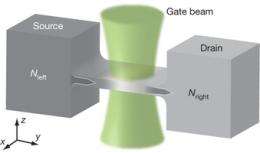November 29, 2012 report
Researchers observe drop of resistance in the flow of a superfluid Fermi gas

(Phys.org)—Physicists working at the Institute for Quantum Electronics in Switzerland have succeeded in building an apparatus that has allowed for the observation of the drop of resistance in the flow of a superfluid Fermi gas. They describe their work in a paper they've had published in the journal Nature.
Researchers have known about superfluidity – materials that have particles that are able to flow with minimal resistance – for approximately 75 years, but up till now have never been able to observe the drop in resistance in an atomic gas superfluid. In this new work, the researchers built an apparatus that allowed them to do just that using nothing but lasers, magnetism and lithium gas.
The team first created a cloud of supercooled lithium gas, then manipulated its shape using laser beams. In so doing they created a dumbbell shaped cloud – two chambers with a channel running between them. Another laser was used to block the lithium atoms from moving across the channel between the chambers serving as a gate. By forcing one chamber to have more lithium atoms than the other, the researchers created an imbalance between the two which caused atoms to flow naturally from one chamber to the other when the laser gate was "lifted." In this controlled manner, the researchers were able to measure the rate at which the atoms moved across the chamber. In a normal state, they found it to be approximately 5 millimeters per second.
In the second stage of the experiment, the researchers added a magnetic field to the same dumbbell shaped lithium cloud to cause the gas to become a superfluid. This time they found when lifting the laser gate and measuring the rate at which the atoms moved across the channel, their speed had risen to 30 millimeters per second. The increased speed came about due to the absence of resistance.
The creation of this simple apparatus marks the first time that scientists have been able to observe the changes that occur when a Fermi gas moves from an ordinary gas to one that is a superfluid. The researchers suggest that observing gases changing this way could lead to advances in supercomputing devices and might even be used to serve as models to help describe the history of the early universe.
More information: Observing the drop of resistance in the flow of a superfluid Fermi gas, Nature, 491, 736–739 (29 November 2012) doi:10.1038/nature11613
Abstract
The ability of particles to flow with very low resistance is characteristic of superfluid and superconducting states, leading to their discovery in the past century1, 2. Although measuring the particle flow in liquid helium or superconducting materials is essential to identify superfluidity or superconductivity, no analogous measurement has been performed for superfluids based on ultracold Fermi gases. Here we report direct measurements of the conduction properties of strongly interacting fermions, observing the well-known drop in resistance that is associated with the onset of superfluidity. By varying the depth of the trapping potential in a narrow channel connecting two atomic reservoirs, we observed variations of the atomic current over several orders of magnitude. We related the intrinsic conduction properties to the thermodynamic functions in a model-independent way, by making use of high-resolution in situ imaging in combination with current measurements. Our results show that, as in solid-state systems, current and resistance measurements in quantum gases provide a sensitive probe with which to explore many-body physics. Our method is closely analogous to the operation of a solid-state field-effect transistor and could be applied as a probe for optical lattices and disordered systems, paving the way for modelling complex superconducting devices.
Journal information: Nature
© 2012 Phys.org



















